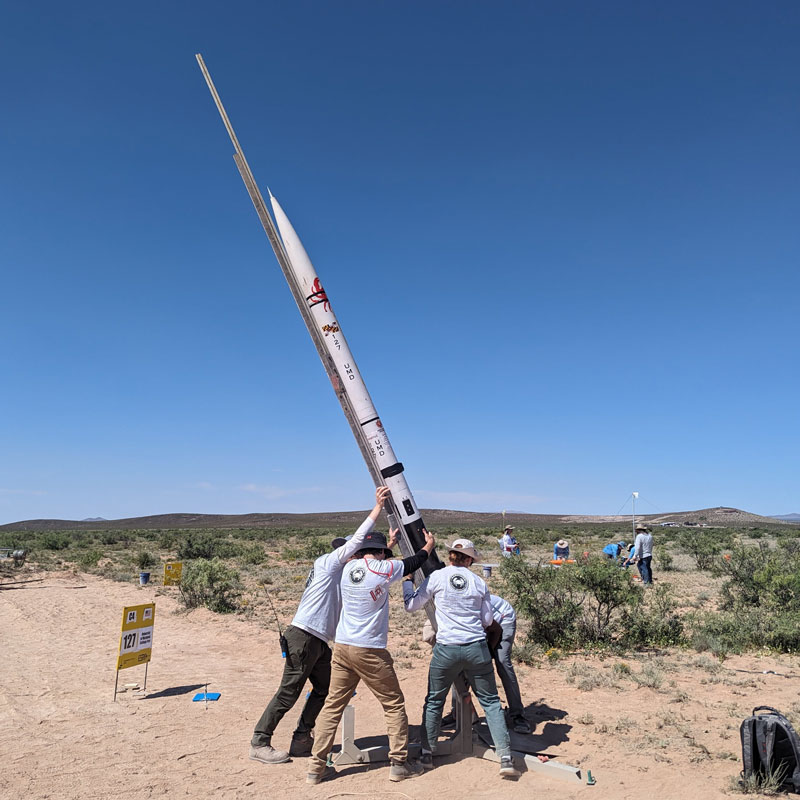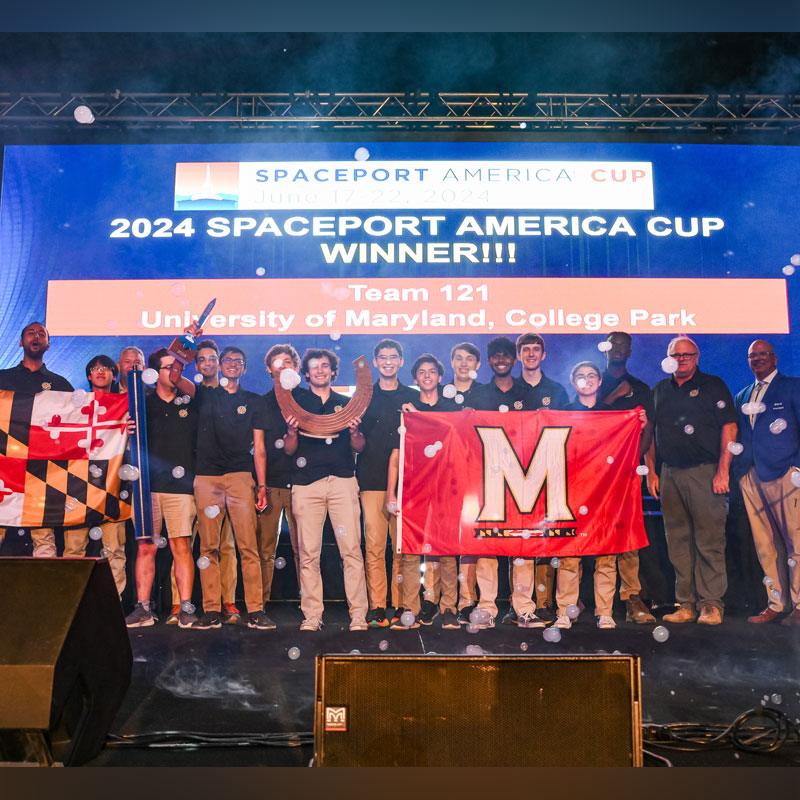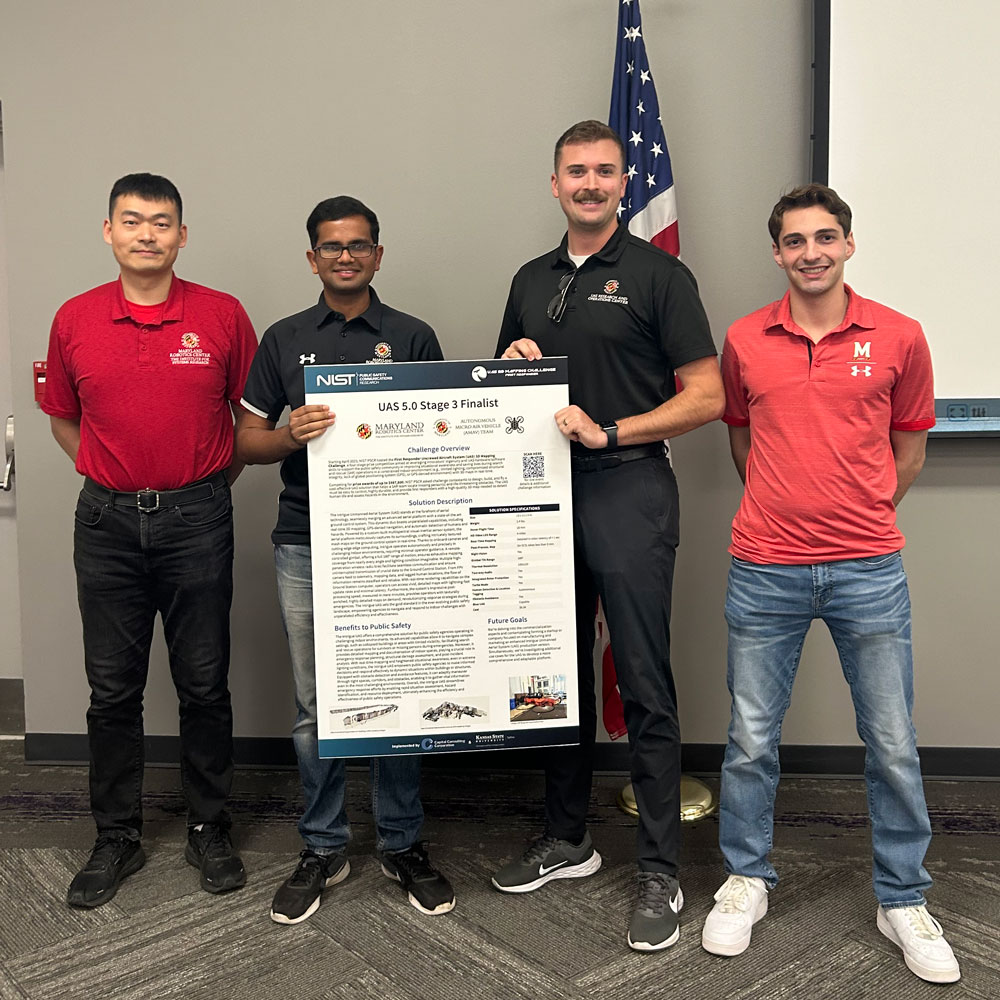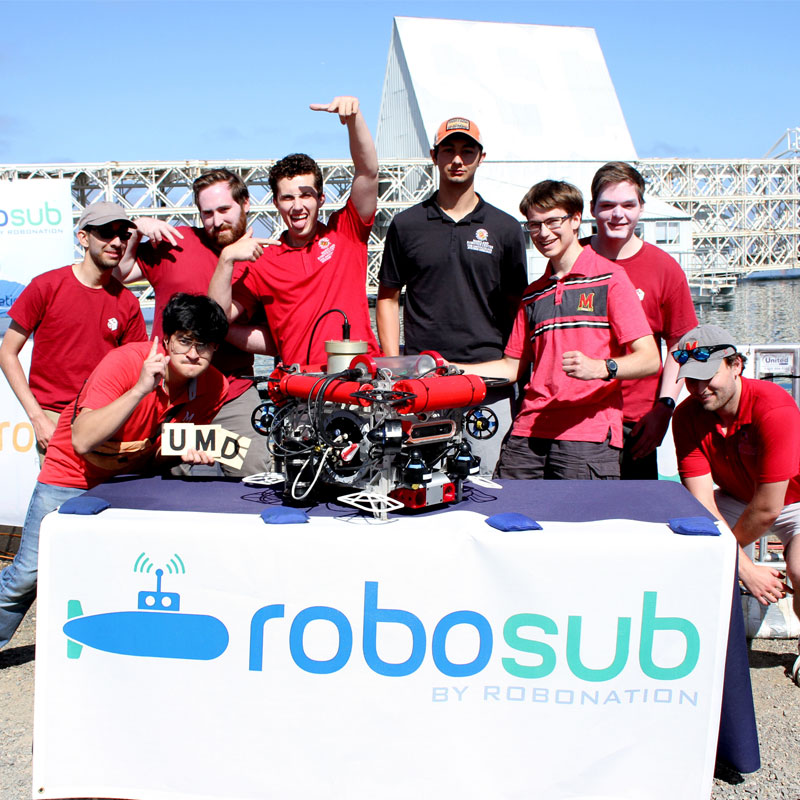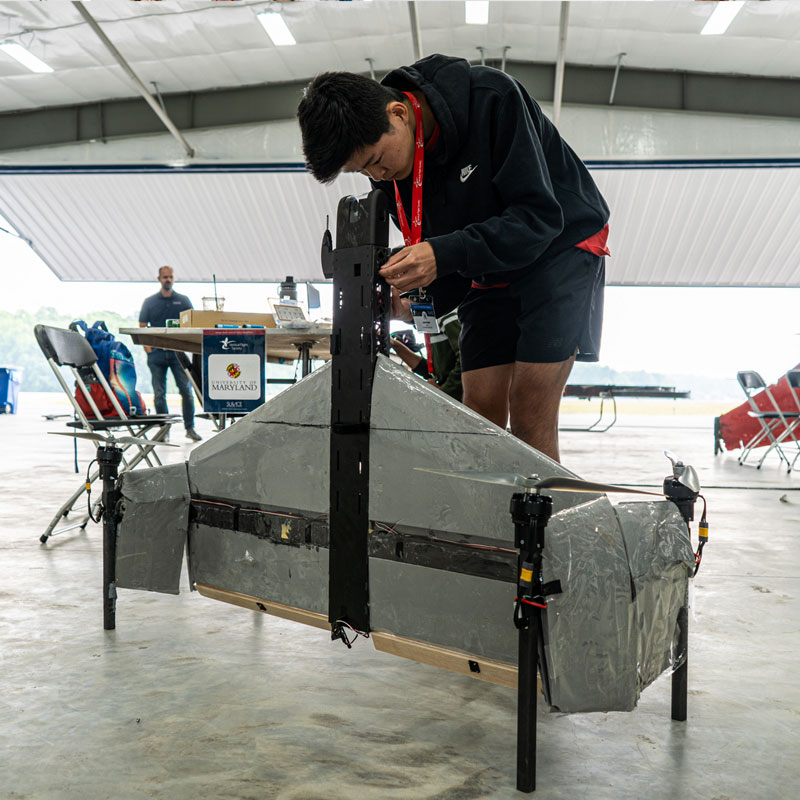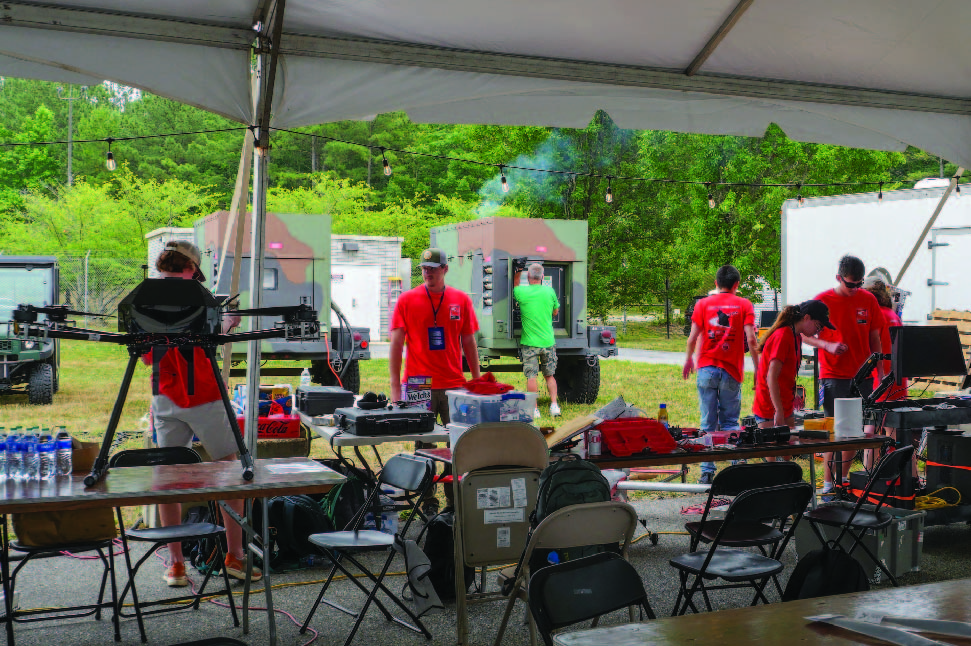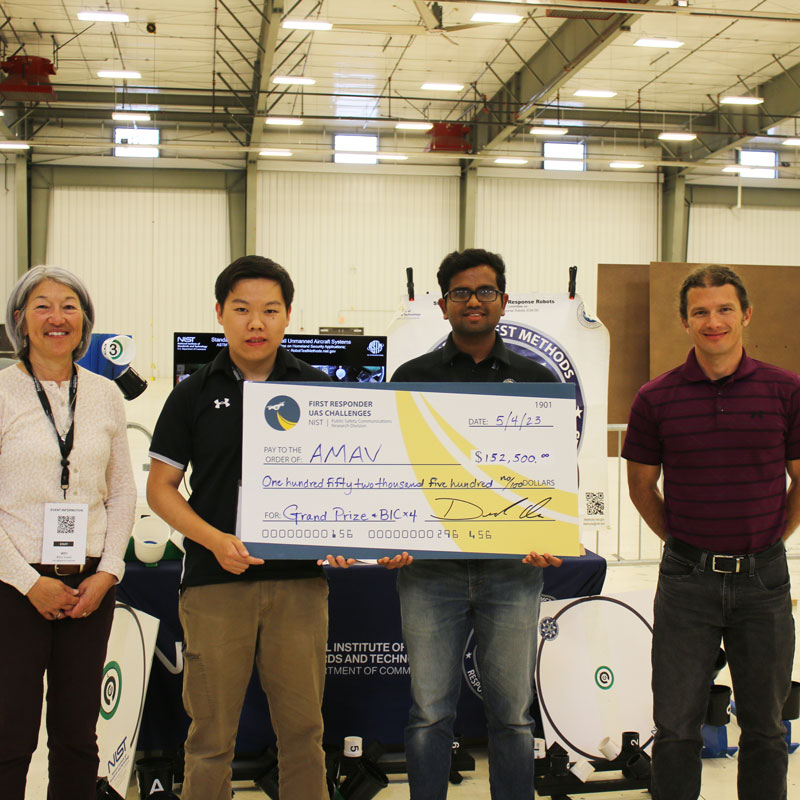News Story
Building a Bigger, Better Rocket Team
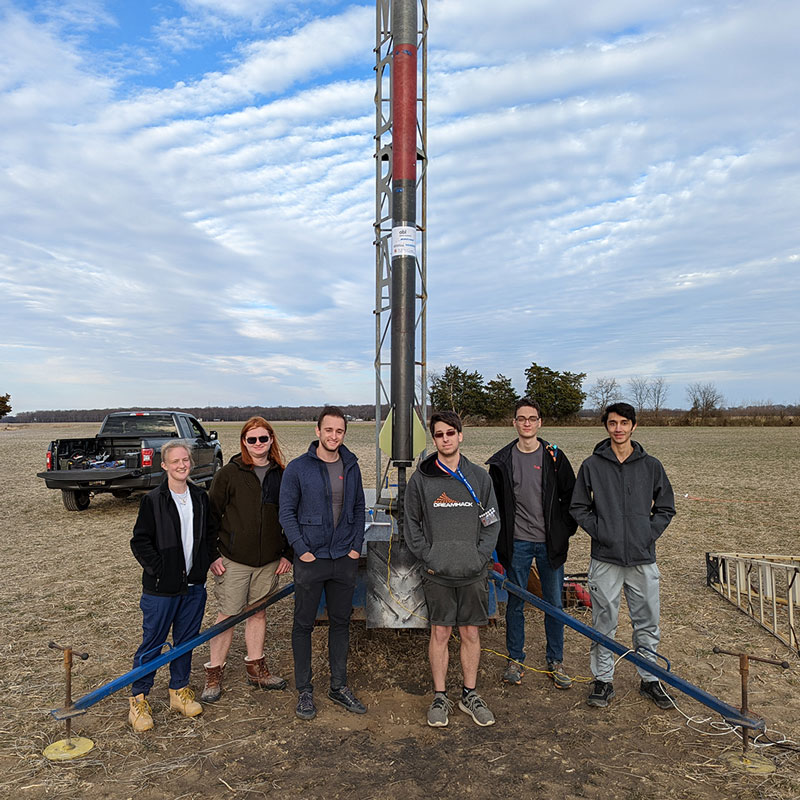
Terrapin Rocket Team members with test rocket.
Launched in 2016, the Terrapin Rocket Team is a cross-disciplined organization that designs, builds, and launches high-powered rockets for competition.
After early success at regional competitions like Battle of the Rockets, the team’s ultimate goal was to compete in the Spaceport America Cup—the world’s largest intercollegiate rocket engineering competition that hosts over 150 teams from across the country and from around the world.
The team took on their first Spaceport challenge in 2019, finishing respectably, but then came 2020.
“Basically, between COVID-19, and most of our team members graduating, we took a huge loss in our knowledge transfer,” said Ezra Bregin, aerospace engineering senior and current team captain. “We somewhat went back to square one.”
Back to the Drawing Board
This year marks only the second time the team has attended the Spaceport competition in New Mexico (2021 went virtual)—and the very first time for all current members—so they are focusing efforts on nailing the basics of rocket design by sticking with the solid motor rocket competition.
“If we can make a reliable rocket, without added complexities, which we can launch and recover, we should do very well,” said Bregin. “While we have ambitions to add more complexities to our rockets in the future, we’re focusing on making sure we have a solid working rocket to take into competition, and we’ll go from there.”
Solid rocket motors are readily available commercially, so the team can focus their efforts on “designing the actual rocket and worrying less about the actual explosion that goes on the bottom.”
While that sounds simple, they will not only be competing in Spaceport’s 10,000-foot category—a precision competition where teams must reach a specific target in altitude, and no further—but they will be doing it with the largest rocket UMD has built. Dubbed Terpulence II, the rocket is 11-feet tall and 6-inches wide.
“Launching is Easy, Recovery is Difficult”
Historically, rocket recovery has been a challenge for the team and since it is a large part of competition scoring, they worked hard to improve their design and methods.
“We’ve been launching rockets every month since August (2021), so our team members are gaining experience and learning to deal with challenges like recovery, issues with the flight computers, ejection charges and more,” explained Bregin.
The team also built a scaled down version of their competition rocket designed specifically for students to practice their construction and recovery techniques.
In addition, the team benefits from a partnership with the Maryland Delaware Rocketry Association (MDRA), which gives them access to launch facilities along with safety and logistics support. A resource many college teams don’t have access to.
If we can make a reliable rocket, without added complexities, which we can launch and recover, we should do very well. While we have ambitions to add more complexities to our rockets in the future, we’re focusing on making sure we have a solid working rocket to take into competition, and we’ll go from there.
Ezra Bregin, Aerospace Engineering Senior and Terrapin Rocket Team President
Building More than Rockets
The team’s long-term goal is to compete in Spaceport’s hybrid motor division, but developing this more complex rocket is a multi-year project and the competition does not allow teams to compete at the more advanced level without previously demonstrating a level of expertise and competency at the more rudimentary levels.
“So that is what we are doing,” said Bregin. “When we competed [virtually] in 2021, we placed respectably, and hopefully we will do so again this year, so we demonstrate our technical ability and it will allow us to move up to the more challenging competitions.”
In the meantime, Bregin is not relying solely on competition performance to support future goals, but he has focused on building robust competencies in team members to ensure the success of multi-year projects.
Part of that plan involves encouraging team members, like sophomore Andrew Bean, to pursue rocketry certifications—multi-level, skill based certification programs designed to ensure safety in hobby rocketry.
 “We really want to encourage these certifications, especially levels one and two, as a way to help team members build their knowledge,” explained Bean, who is also team vice-president and a rocket enthusiast since high school. “If you learn to build a level-one rocket, you’ll have good working knowledge on how to build the competition rocket, and no matter where you go on the team, it helps make their designs better.”
“We really want to encourage these certifications, especially levels one and two, as a way to help team members build their knowledge,” explained Bean, who is also team vice-president and a rocket enthusiast since high school. “If you learn to build a level-one rocket, you’ll have good working knowledge on how to build the competition rocket, and no matter where you go on the team, it helps make their designs better.”
The team also leverages members like junior Elias Hailu Daniel (pictured at right), who joined Terrapin Rockets to not only get hands-on experience, but also build on experience gained from an internship at ABL Space Systems, a launch systems company in California.
“It’s a great opportunity to build on what I learned at ABL, share what I know with team members and learn what I don’t know,” said Daniel, who is lead for the team’s aerostructures sub-team responsible for the design and manufacture of the rocket.
Looking Ahead

Bregin is optimistic that the team will continue to grow in members, activity and influence, and added, “I would love that we build a robust enough team, that in the future, we’ll have a liquid team, a solid team and a hybrid team.”
The team is not exclusive to aerospace engineers and they know that there are a lot of disciplines who could find something to love in Terrapin Rockets as they aim for their next goals.
“There are so many different experiences that this team has to offer, that no matter your major, it’s a great opportunity to learn and grow,” said Daniel. “As long as you have a passion for rockets, that’s what we’re looking for!”
“We see a bright future ahead for the team,” said Bregin. “And I want to see the team continue to grow and evolve as not only a rocketry and competition team, but a vibrant team that is engaged with the department, the school and the university.”
Published March 1, 2022
